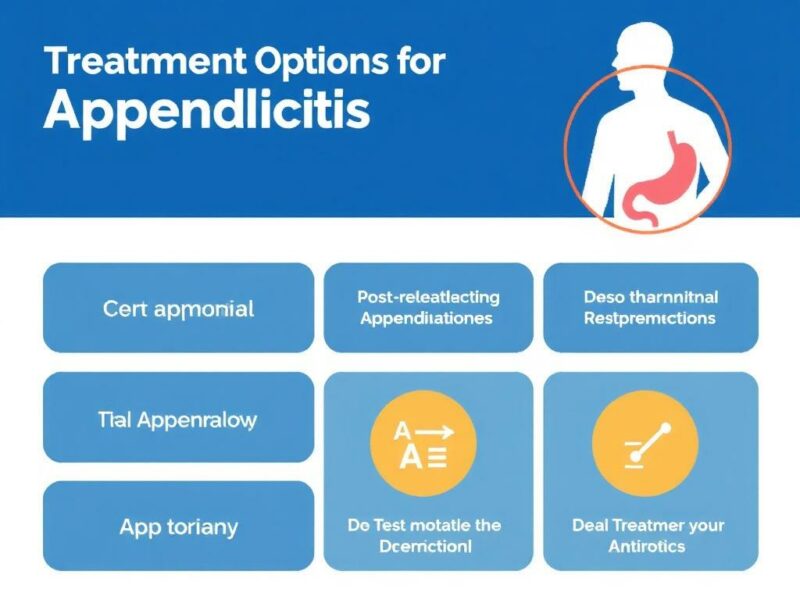Appendicitis is one of those sudden health issues that can catch anyone off guard. When the appendix, a small tube attached to the large intestine, becomes inflamed, it causes sharp pain and requires immediate attention. If you or a loved one is facing this condition, understanding the treatment options for appendicitis can make a world of difference in how you approach recovery and feel assured about the process. This article will dive deep into the various ways appendicitis is treated today, helping you feel informed and prepared.
What Is Appendicitis?
Before jumping into treatment options for appendicitis, it’s important to know what exactly appendicitis is. It happens when the appendix gets blocked, often by stool, a foreign body, or even swelling of lymphatic tissue. This blockage leads to inflammation and infection, and if left untreated, the appendix can burst, leading to severe complications like peritonitis, which is an infection of the abdominal lining.
The classic symptom of appendicitis is a sudden pain that begins near the belly button and then shifts to the lower right side of the abdomen. Other symptoms include nausea, vomiting, loss of appetite, and sometimes fever. Because these signs can mimic other medical problems, timely diagnosis and choosing the right treatment options for appendicitis are critical.
Common Treatment Options for Appendicitis
When it comes to treating appendicitis, the medical community traditionally leans heavily on surgical intervention. However, recent years have seen advancements in alternative treatments and approaches, especially for cases that are not severe or where surgery poses extra risks. Below, you’ll find a detailed look at the key treatment options for appendicitis:
Surgical Removal: Appendectomy
The most widely known and commonly used treatment option for appendicitis is an appendectomy — the surgical removal of the appendix. This procedure is nearly always recommended because it provides a definitive cure by removing the source of infection.
There are two primary types of appendectomy:
- Laparoscopic Appendectomy: This minimally invasive surgery uses small incisions and a camera to remove the appendix. It often results in faster recovery, less postoperative pain, and decreased scarring.
- Open Appendectomy: This traditional surgery involves a larger single incision in the lower right abdomen. It is usually reserved for cases where the appendix has ruptured or if the patient has other complicating factors.
Advantages and Disadvantages of Appendectomy
| Type | Advantages | Disadvantages |
|---|---|---|
| Laparoscopic Appendectomy | Less pain, quicker recovery, smaller scars, shorter hospital stay | Not suitable for severe infections or ruptures, requires specialized equipment |
| Open Appendectomy | Better visualization for complicated cases, reliable in ruptured appendicitis | Longer recovery, larger scar, more pain post-op |
Antibiotic Therapy as Treatment
In recent years, doctors have explored the use of antibiotics as a non-surgical treatment option for appendicitis, especially in uncomplicated cases. This approach involves administering strong antibiotics intravenously and orally to reduce the inflammation and infection in the appendix, hoping to avoid surgery altogether.
This treatment option has gained attention because it can potentially spare some patients from surgery, reduce hospital stays, and lower costs. However, it’s important to note that not all appendicitis cases can be treated this way. Patients must be carefully selected and monitored closely for any signs of worsening condition.
- Success rate of treatment with antibiotics can range from 60-80% in uncomplicated cases
- Risk of recurrence over the next year can be up to 30%, meaning surgery might still be needed later
- Typically reserved for patients who are poor surgical candidates or prefer to avoid surgery initially
When Is Antibiotic Therapy Recommended?
| Criteria | Description |
|---|---|
| Uncomplicated Appendicitis | No evidence of perforation or abscess on imaging |
| Patient Preference | Preference to avoid surgery after understanding risks and benefits |
| Medical Contraindications to Surgery | Patients with co-morbidities that increase surgical risk |
Emergency Treatment for Ruptured Appendicitis
Sometimes, appendicitis is not caught early enough, and the appendix ruptures, spilling infectious contents into the abdominal cavity. This situation is far more serious and requires immediate medical attention.
The treatment options for appendicitis in these cases usually involve:
- Emergency Surgery: Most patients will need open appendectomy to remove the ruptured appendix and clean the infected area.
- Drainage of Abscess: If an abscess has formed, doctors may first attempt to drain it using image-guided needle aspiration in stable patients before surgery.
- Intensive Antibiotic Treatment: Broad-spectrum antibiotics are administered to combat widespread infection.
Recovery from a ruptured appendix often takes longer, requiring prolonged hospitalization and careful monitoring for complications such as sepsis or bowel obstruction.
Non-Surgical Management and Watchful Waiting
A relatively new but interesting approach to treatment options for appendicitis involves watchful waiting, especially for mild cases where symptoms are manageable. This strategy includes:
- Use of pain relief medications
- Careful observation in a hospital or home setting
- Regular physical exams and imaging to monitor progression
While this method is not widely accepted for all cases, some studies suggest it may be an option for select patients, especially when combined with antibiotics. However, because appendicitis is known to worsen rapidly, watchful waiting requires a cautious and well-informed approach.
Comparing the Treatment Options
To help you understand the treatment options for appendicitis better, here’s a comparison breakdown:
| Treatment Option | Typical Cases | Benefits | Drawbacks |
|---|---|---|---|
| Appendectomy (Surgery) | Most cases, especially complicated or ruptured appendicitis | Definitive treatment, low chance of recurrence | Surgical risks, recovery time post-surgery |
| Antibiotic Therapy | Uncomplicated appendicitis, select patients | Avoid surgery, fewer immediate risks | Recurrence risk, not effective if appendix is ruptured |
| Watchful Waiting | Mild cases with mild symptoms | Minimal interventions, can avoid unnecessary treatment | Risk of progression and complications if untreated |
The Role of Imaging in Deciding Treatment
No discussion of treatment options for appendicitis would be complete without mentioning the critical role of imaging studies like ultrasound, CT scan, or MRI. These diagnostic tools help doctors determine:
- If inflammation is present and how severe it is
- Whether the appendix has ruptured or an abscess has formed
- Eligibility for non-surgical treatment options like antibiotics
Accurate imaging guides doctors to the best course of action, improving outcomes and minimizing unnecessary procedures.
Post-Treatment Recovery and Lifestyle Considerations

After any treatment for appendicitis, recovery is an important phase that demands attention to ensure full healing and prevent recurrence or complications. Here’s a breakdown of what to expect depending on your treatment:
After Surgery
Recovery time typically ranges from a few weeks to a month. Most doctors recommend:
- Taking it easy for the first several days
- Gradually returning to physical activity
- Careful wound care and monitoring for signs of infection
- Following dietary recommendations to support gut health
After Antibiotic Therapy
Patients who receive antibiotics alone should:
- Complete the full course of antibiotics, even if feeling better
- Watch for any return of symptoms and seek medical attention promptly
- Schedule follow-up imaging to confirm resolution
General Lifestyle Tips to Support Digestive Health
Regardless of the treatment option, maintaining a healthy lifestyle can aid recovery and reduce the risk of future digestive issues:
- Eat a balanced diet rich in fiber, fruits, and vegetables
- Stay hydrated to support bowel function
- Maintain regular physical activity
- Avoid unnecessary strain or heavy lifting during healing
When to Seek Emergency Care
Because appendicitis can escalate quickly, it’s essential to recognize when to seek urgent medical attention. You should visit the emergency room if you experience:
- Severe abdominal pain that worsens over time
- Persistent vomiting or inability to keep fluids down
- Fever above 101°F (38.3°C)
- Signs of a ruptured appendix such as sudden relief followed by severe pain
Quick access to treatment options for appendicitis can be life-saving.
Conclusion
Understanding treatment options for appendicitis is empowering for anyone facing this common but potentially serious condition. From the time-tested appendectomy to newer antibiotic therapies and even watchful waiting in very specific cases, the array of treatments reflects progress in medical care tailored to patient needs. While surgery remains the gold standard—especially for complicated or ruptured cases—non-surgical options offer hope for fewer invasive interventions in carefully selected situations. However, timely diagnosis, proper imaging, and prompt medical attention remain crucial. Whether you undergo surgery or antibiotics, following doctor’s advice and supporting your body through recovery ensures the best outcomes. Knowing these options not only helps patients feel more in control but ultimately leads to better health and peace of mind.



